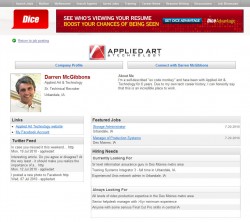 Job boards have been declared dead or dying so often that keeping track of the pronouncements is about as easy as counting the number of job boards in the world.
Job boards have been declared dead or dying so often that keeping track of the pronouncements is about as easy as counting the number of job boards in the world.
Google comes up with 222,000 references for a search on the keywords: “job board”, dead OR dying.
Yet, for all that, the number of job boards is proliferating and there are still plenty of believers in the model ready to launch more. A good part of the recent debate over the .jobs domain expansion was about DirectEmployers Association’s plan to launch tens of thousands of more job boards.
What’s keeping job boards in the game is their ability to deliver candidates and their ability to incorporate recruiter trends without mindlessly following the pack.
Without a doubt, there are plenty of skeptics to both of those claims. In the first instance, Eric Shannon, a job board founder himself, offered evidence to show that the hiring of candidates from job boards has been growing over the years, as has the number of job boards themselves. His reference to CareerXroads 2010 Sources of Hire study points out that after employee referrals and a company’s own career site, job boards provide the most number of external hires.
The second reason job boards have survived is their evolutionary behavior. Each time a new killer app or trend has come along, the job boards have morphed, co-opting it or integrating it.
Since last year we have seen pretty clearly how the job boards are responding to the surge of interest in social media recruiting. In fact, just since the summer began Dice.com and its sister site, ClearanceJobs.com, have aggressively imitated some of the best of the social media elements, creating a Dice Talent Network on its flagship IT site and Cleared Network on its security clearance jobs board.
Dice, incidentally, is one of the job boards using multiple social channels to promote itself. It has its own You Tube channel and its own DiceNews video service.
CareerBuilder a few months back added several new features, including a Talent Network service that helps recruiters build their pipeline by identifying where the best candidates can be found. Its hireINSIDER is aimed at job seekers and lets them see how they compare in experience, skills, and education to others pursuing the same job.
Smaller job boards — in traffic and resources — have been no less aggressive in adding function and interest. Among other improvements, AfterCollege.com has overhauled its company profiles, converting what industry-wide has been a dreary corporate factsheet into a much more interesting presence that borrows liberally from Facebook. Beyond.com, by no means small cumulatively with 15,000 or so sites, has introduced applications for smart phones and has jumped into video with a YouTube presence.
And, like the major national job boards, many, perhaps most, now distribute their job postings via Twitter, Facebook, and/or LinkedIn.
 These changes — and plenty of others — are how the job boards have maintained their position as one of the most effective means of sourcing candidates. The September issue of The Journal of Corporate Recruiting Leadership details the integration of social media by the job board industry and offers snapshots of what some of them have done.
These changes — and plenty of others — are how the job boards have maintained their position as one of the most effective means of sourcing candidates. The September issue of The Journal of Corporate Recruiting Leadership details the integration of social media by the job board industry and offers snapshots of what some of them have done.
The article also looks ahead at the next-biggest job board move, one that has been underway for a few years, but which is about to accelerate even faster than it did following the introduction of the first iPhone.
As noted recruiting authority and executive director of the job board industry’s trade group, Peter Weddle says, mobile ”is the next big thing.”